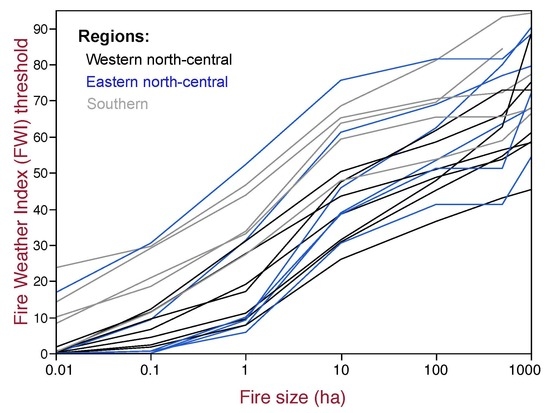Variation in the Canadian Fire Weather Index Thresholds for Increasingly Larger Fires in Portugal
Abstract
1. Introduction
2. Materials and Methods
2.1. Data
2.2. Data Analyses
3. Results
4. Discussion
4.1. FWI Thresholds for Increasingly Larger Fires and Fire Danger Rating
4.2. Regional Variation in Fire-Size Response to the FWI
5. Conclusions
Supplementary Materials
Funding
Acknowledgments
Conflicts of Interest
References
- Bowman, D.M.J.S.; Williamson, G.J.; Abatzoglou, J.T.; Kolden, C.A.; Cochrane, M.A.; Smith, A.M.S. Human exposure and sensitivity to globally extreme wildfire events. Nat. Ecol. Evol. 2017, 1, 0058. [Google Scholar] [CrossRef] [PubMed]
- Turco, M.; Herrera, S.; Tourigny, E.; Chuvieco, E.; Provenzale, A. A comparison of remotely-sensed and inventory datasets for burned area in Mediterranean Europe. Int. J. Appl. Earth Obs. 2019, 82, 101887. [Google Scholar] [CrossRef]
- Mateus, P.; Fernandes, P.M. Forest Fires in Portugal: Dynamics, Causes and Policies. In Forest Context and Policies in Portugal; Reboredo, F., Ed.; Springer International Publishing: Cham, Switzerland, 2014; pp. 97–115. [Google Scholar]
- Martell, D.L. Forest Fire Management. In Handbook of Operations Research In Natural Resources; Weintraub, A., Romero, C., Bjørndal, T., Epstein, R., Miranda, J., Eds.; Springer: Boston, MA, USA, 2007; pp. 489–509. [Google Scholar]
- Wotton, B.M. Interpreting and using outputs from the Canadian Forest Fire Danger Rating System in research applications. Environ. Ecol. Stat. 2009, 16, 107–131. [Google Scholar] [CrossRef]
- Stocks, B.J.; Lynham, T.J.; Lawson, B.D.; Alexander, M.E.; Wagner, C.V.; McAlpine, R.S.; Dube, D.E. Canadian forest fire danger rating system: An overview. For. Chron. 1989, 65, 258–265. [Google Scholar] [CrossRef]
- Burgan, R.E. 1988 Revisions to the 1978 National Fire-Danger Rating System; US Department of Agriculture, Forest Service, Southeastern Forest Experiment Station: Asheville, NC, USA, 1988; p. 144.
- Matthews, S. A comparison of fire danger rating systems for use in forests. Aust. Meteorol. Ocean. 2009, 58, 41. [Google Scholar] [CrossRef]
- Van Wagner, C.E. Development and Structure of the Canadian Forest Fire Weather Index System; Forestry Technical Report 35; Canadian Forest Service: Ottawa, ON, Canada, 1987; p. 35. [Google Scholar]
- Palheiro, P.M.; Fernandes, P.; Cruz, M.G. A fire behaviour-based fire danger classification for maritime pine stands: Comparison of two approaches. For. Ecol. Manag. 2006, 234, S54. [Google Scholar] [CrossRef]
- Andrews, P.L.; Loftsgaarden, D.O.; Bradshaw, L.S. Evaluation of fire danger rating indexes using logistic regression and percentile analysis. Int. J. Wildland Fire 2003, 12, 213–226. [Google Scholar] [CrossRef]
- DaCamara, C.C.; Calado, T.J.; Ermida, S.L.; Trigo, I.F.; Amraoui, M.; Turkman, K.F. Calibration of the Fire Weather Index over Mediterranean Europe based on fire activity retrieved from MSG satellite imagery. Int. J. Wildland Fire 2014, 23, 945–958. [Google Scholar] [CrossRef]
- Davies, G.M.; Legg, C.J. Regional variation in fire weather controls the reported occurrence of Scottish wildfires. PeerJ 2016, 4, e2649. [Google Scholar] [CrossRef]
- De Jong, M.C.; Wooster, M.J.; Kitchen, K.; Manley, C.; Gazzard, R.; McCall, F.F. Calibration and evaluation of the Canadian Forest Fire Weather Index (FWI) System for improved wildland fire danger rating in the United Kingdom. Nat. Hazard Earth Sys. 2016, 16, 1217–1237. [Google Scholar] [CrossRef]
- Šturm, T.; Fernandes, P.M.; Šumrada, R. The Canadian fire weather index system and wildfire activity in the Karst forest management area, Slovenia. Eur. J. For. Res. 2012, 131, 829–834. [Google Scholar] [CrossRef]
- Amatulli, G.; Camia, A.; San-Miguel-Ayanz, J. Estimating future burned areas under changing climate in the EU-Mediterranean countries. Sci. Total Environ. 2013, 450–451, 209–222. [Google Scholar] [CrossRef] [PubMed]
- Carvalho, A.; Flannigan, M.D.; Logan, K.; Miranda, A.I.; Borrego, C. Fire activity in Portugal and its relationship to weather and the Canadian Fire Weather Index System. Int. J. Wildland Fire 2008, 17, 328–338. [Google Scholar] [CrossRef]
- Giannakopoulos, C.; LeSager, P.; Moriondo, M.; Bindi, M.; Karali, A.; Hatzaki, M.; Kostopoulou, E. Comparison of fire danger indices in the Mediterranean for present day conditions. iForest 2012, 5, 197. [Google Scholar] [CrossRef]
- Jiménez-Ruano, A.; Mimbrero, M.R.; Jolly, W.M.; de la Riva Fernández, J. The role of short-term weather conditions in temporal dynamics of fire regime features in mainland Spain. J. Environ. Manag. 2019, 241, 575–586. [Google Scholar] [CrossRef] [PubMed]
- Padilla, M.; Vega-García, C. On the comparative importance of fire danger rating indices and their integration with spatial and temporal variables for predicting daily human-caused fire occurrences in Spain. Int. J. Wildland Fire 2011, 20, 46–58. [Google Scholar] [CrossRef]
- Papakosta, P.; Straub, D. Probabilistic prediction of daily fire occurrence in the Mediterranean with readily available spatio-temporal data. iForest 2016, 10, 32. [Google Scholar] [CrossRef]
- Urbieta, I.R.; Zavala, G.; Bedia, J.; Gutiérrez, J.M.; Miguel-Ayanz, J.S.; Camia, A.; Keeley, J.E.; Moreno, J.M. Fire activity as a function of fire—weather seasonal severity and antecedent climate across spatial scales in southern Europe and Pacific western USA. Environ. Res. Lett. 2015, 10, 114013. [Google Scholar] [CrossRef]
- Venäläinen, A.; Korhonen, N.; Hyvärinen, O.; Koutsias, N.; Xystrakis, F.; Urbieta, I.R.; Moreno, J.M. Temporal variations and change in forest fire danger in Europe for 1960–2012. Nat. Hazards Earth Sys. 2014, 14, 1477–1490. [Google Scholar] [CrossRef]
- Ager, A.A.; Preisler, H.K.; Arca, B.; Spano, D.; Salis, M. Wildfire risk estimation in the Mediterranean area. Environmetrics 2014, 25, 384–396. [Google Scholar] [CrossRef]
- Fernandes, P.M.; Barros, A.M.G.; Pinto, A.; Santos, J.A. Characteristics and controls of extremely large wildfires in the western Mediterranean Basin. J. Geophys. Res. Biogeo 2016, 121, 2141–2157. [Google Scholar] [CrossRef]
- Fernandes, P.M.; Pacheco, A.P.; Almeida, R.; Claro, J. The role of fire-suppression force in limiting the spread of extremely large forest fires in Portugal. Eur. J. For. Res. 2016, 135, 253–262. [Google Scholar] [CrossRef]
- Fernandes, P.M.; Monteiro-Henriques, T.; Guiomar, N.; Loureiro, C.; Barros, A.M.G. Bottom-up variables govern large-fire size in Portugal. Ecosystems 2016, 19, 1362–1375. [Google Scholar] [CrossRef]
- Lahaye, S.; Curt, T.; Fréjaville, T.; Sharples, J.; Paradis, L.; Hély, C. What are the drivers of dangerous fires in Mediterranean France? Int. J. Wildland Fire 2018, 27, 155–163. [Google Scholar] [CrossRef]
- Strauss, D.; Bednar, L.; Mees, R. Do one percent of the forest fires cause ninety-nine percent of the damage? For. Sci. 1989, 35, 319–328. [Google Scholar]
- Lannom, K.O.; Tinkham, W.T.; Smith, A.M.S.; Abatzoglou, J.; Newingham, B.A.; Hall, T.E.; Morgan, P.; Strand, E.K.; Paveglio, T.B.; Anderson, J.W.; et al. Defining extreme wildland fires using geospatial and ancillary metrics. Int. J. Wildland Fire 2014, 23, 322–337. [Google Scholar] [CrossRef]
- Cui, W.; Perera, A.H. What do we know about forest fire size distribution, and why is this knowledge useful for forest management? Int. J. Wildland Fire 2008, 17, 234–244. [Google Scholar] [CrossRef]
- Arienti, M.C.; Cumming, S.G.; Boutin, S. Empirical models of forest fire initial attack success probabilities: The effects of fuels, anthropogenic linear features, fire weather, and management. Can. J. For. Res. 2006, 36, 3155–3166. [Google Scholar] [CrossRef]
- Fang, L.; Yang, J.; Zu, J.; Li, G.; Zhang, J. Quantifying influences and relative importance of fire weather, topography, and vegetation on fire size and fire severity in a Chinese boreal forest landscape. For. Ecol. Manag. 2015, 356, 2–12. [Google Scholar] [CrossRef]
- Moreira, F.; Catry, F.X.; Rego, F.; Bacao, F. Size-dependent pattern of wildfire ignitions in Portugal: When do ignitions turn into big fires? Landsc. Ecol. 2010, 25, 1405–1417. [Google Scholar] [CrossRef]
- Ruffault, J.; Mouillot, F. Contribution of human and biophysical factors to the spatial distribution of forest fire ignitions and large wildfires in a French Mediterranean region. Int. J. Wildland Fire 2017, 26, 498–508. [Google Scholar] [CrossRef]
- Price, O.F.; Penman, T.; Bradstock, R.; Borah, R. The drivers of wildfire enlargement do not exhibit scale thresholds in southeastern Australian forests. J. Environ. Manag. 2016, 181, 208–217. [Google Scholar]
- Whitman, E.; Batllori, E.; Parisien, M.-A.; Miller, C.; Coop, J.D.; Krawchuk, M.A.; Chong, G.W.; Haire, S.L. The climate space of fire regimes in north-western North America. J. Biogeogr. 2015, 42, 1736–1749. [Google Scholar] [CrossRef]
- Bowman, D.M.J.S.; Balch, J.; Artaxo, P.; Bond, W.J.; Cochrane, M.A.; D’Antonio, C.M.; DeFries, R.; Johnston, F.H.; Keeley, J.E.; Krawchuk, M.A.; et al. The human dimension of fire regimes on Earth: The human dimension of fire regimes on Earth. J. Biogeogr. 2011, 38, 2223–2236. [Google Scholar] [CrossRef]
- Parisien, M.-A.; Miller, C.; Parks, S.A.; DeLancey, E.R.; Robinne, F.-N.; Flannigan, M.D. The spatially varying influence of humans on fire probability in North America. Environ. Res. Lett. 2016, 11, 075005. [Google Scholar] [CrossRef]
- Syphard, A.D.; Keeley, J.E.; Pfaff, A.H.; Ferschweiler, K. Human presence diminishes the importance of climate in driving fire activity across the United States. Proc. Natl. Acad. Sci. USA 2017, 114, 13750–13755. [Google Scholar] [CrossRef]
- Ruffault, J.; Mouillot, F. How a new fire-suppression policy can abruptly reshape the fire-weather relationship. Ecosphere 2015, 6, art199. [Google Scholar] [CrossRef]
- Bedia, J.; Herrera, S.; Gutiérrez, J.M. Assessing the predictability of fire occurrence and area burned across phytoclimatic regions in Spain. Nat. Hazards Earth Sys. 2014, 14, 53–66. [Google Scholar] [CrossRef]
- Jiménez-Ruano, A.; Mimbrero, M.R.; de la Riva Fernández, J. Understanding wildfires in mainland Spain. A comprehensive analysis of fire regime features in a climate-human context. Appl. Geogr. 2017, 89, 100–111. [Google Scholar] [CrossRef]
- Trigo, R.M.; Sousa, P.M.; Pereira, M.G.; Rasilla, D.; Gouveia, C.M. Modelling wildfire activity in Iberia with different atmospheric circulation weather types. Int. J. Climatol. 2016, 36, 2761–2778. [Google Scholar]
- Costa, L.; Thonicke, K.; Poulter, B.; Badeck, F.-W. Sensitivity of Portuguese forest fires to climatic, human, and landscape variables: Subnational differences between fire drivers in extreme fire years and decadal averages. Reg. Environ. Change 2011, 11, 543–551. [Google Scholar] [CrossRef]
- Marques, S.; Borges, J.G.; Garcia-Gonzalo, J.; Moreira, F.; Carreiras, J.M.B.; Oliveira, M.M.; Cantarinha, A.; Botequim, B.; Pereira, J.M.C. Characterization of wildfires in Portugal. Eur. J. For. Res. 2011, 130, 775–784. [Google Scholar] [CrossRef]
- Sá, A.C.L.; Turkman, M.A.A.; Pereira, J.M.C. Exploring fire incidence in Portugal using generalized additive models for location, scale and shape (GAMLSS). Model. Earth Syst. Environ. 2018, 4, 199–220. [Google Scholar] [CrossRef]
- Moreno, M.V.; Conedera, M.; Chuvieco, E.; Pezzatti, G.B. Fire regime changes and major driving forces in Spain from 1968 to 2010. Environ. Sci. Policy 2014, 37, 11–22. [Google Scholar] [CrossRef]
- ICNF. Available online: http://www2.icnf.pt/portal/florestas/dfci/inc/estat-sgif (accessed on 20 August 2019).
- ICNF—Cartografia da área Ardida. Available online: http://www2.icnf.pt/portal/florestas/dfci/inc/mapas (accessed on 20 August 2019).
- Catry, F.X.; Rego, F.C.; Bação, F.L.; Moreira, F. Modeling and mapping wildfire ignition risk in Portugal. Int. J. Wildland Fire 2010, 18, 921–931. [Google Scholar] [CrossRef]
- Riley, S.J.; DeGloria, S.D.; Elliot, R. A terrain ruggedness index that quantifies topographic heterogeneity. Intermt. J. Sci. 1999, 5, 23–27. [Google Scholar]
- Imhoff, M.L.; Bounoua, L.; Ricketts, T.; Loucks, C.; Harriss, R.; Lawrence, W.T. HANPP Collection: Global Patterns in Net Primary Productivity (NPP); SEDAC: Palisades, NY, USA, 2004. [Google Scholar]
- Imhoff, M.L.; Bounoua, L. Exploring global patterns of net primary production carbon supply and demand using satellite observations and statistical data. J. Geophys. Res.-Atmos. 2006, 111, D22. [Google Scholar] [CrossRef]
- ICNF, Relatório Final IFN5—FloreStat. Available online: http://www2.icnf.pt/portal/florestas/ifn/ifn5/rel-fin (accessed on 20 August 2019).
- Fernandes, P.M. Combining forest structure data and fuel modelling to classify fire hazard in Portugal. Ann. For. Sci. 2009, 66, 415. [Google Scholar] [CrossRef]
- Barros, A.M.G.; Pereira, J.M.C. Wildfire selectivity for land cover type: Does size matter? PLoS ONE 2014, 9, e84760. [Google Scholar] [CrossRef]
- Moreira, F.; Vaz, P.; Catry, F.; Silva, J.S. Regional variations in wildfire susceptibility of land-cover types in Portugal: Implications for landscape management to minimize fire hazard. Int. J. Wildland Fire 2009, 18, 563–574. [Google Scholar] [CrossRef]
- Jolly, W.M.; Freeborn, P.H.; Page, W.G.; Butler, B.W. Severe fire danger index: A forecastable metric to inform firefighter and community wildfire risk management. Fire 2019, 2, 47. [Google Scholar] [CrossRef]
- Hosmer, D.W.; Lemeshow, S. Applied Logistic Regression, 2nd ed.; Wiley: New York, NY, USA, 2000; p. 375. [Google Scholar]
- Amraoui, M.; Pereira, M.G.; DaCamara, C.C.; Calado, T.J. Atmospheric conditions associated with extreme fire activity in the Western Mediterranean region. Sci. Total Environ. 2015, 524–525, 32–39. [Google Scholar]
- Cruz, M.G.; Alexander, M.E. The 10% wind speed rule of thumb for estimating a wildfire’s forward rate of spread in forests and shrublands. Ann. For. Sci. 2019, 76, 44. [Google Scholar]
- Potter, B.E. Atmospheric interactions with wildland fire behaviour—II. Plume and vortex dynamics. Int. J. Wildland Fire 2012, 21, 802–817. [Google Scholar]
- Viedma, O.; Angeler, D.G.; Moreno, J.M. Landscape structural features control fire size in a Mediterranean forested area of central Spain. Int. J. Wildland Fire 2009, 18, 575–583. [Google Scholar] [CrossRef]
- Fernandes, P.M.; Loureiro, C.; Magalhães, M.; Ferreira, P.; Fernandes, M. Fuel age, weather and burn probability in Portugal. Int. J. Wildland Fire 2012, 21, 380–384. [Google Scholar] [CrossRef]
- Koutsias, N.; Arianoutsou, M.; Kallimanis, A.S.; Mallinis, G.; Halley, J.M.; Dimopoulos, P. Where did the fires burn in Peloponnisos, Greece the summer of 2007? Evidence for a synergy of fuel and weather. Agr. For. Meteorol. 2012, 156, 41–53. [Google Scholar]
- Abatzoglou, J.T.; Balch, J.K.; Bradley, B.A.; Kolden, C.A. Human-related ignitions concurrent with high winds promote large wildfires across the USA. Int. J. Wildland Fire 2018, 27, 377–386. [Google Scholar] [CrossRef]
- Slocum, M.G.; Beckage, B.; Platt, W.J.; Orzell, S.L.; Taylor, W. Effect of climate on wildfire size: A cross-scale analysis. Ecosystems 2010, 13, 828–840. [Google Scholar] [CrossRef]
- Nunes, A.N. Regional variability and driving forces behind forest fires in Portugal an overview of the last three decades (1980–2009). Appl. Geogr. 2012, 34, 576–586. [Google Scholar] [CrossRef]
- Pausas, J.G.; Paula, S. Fuel shapes the fire—climate relationship: Evidence from Mediterranean ecosystems. Global Ecol. Biogeogr. 2012, 21, 1074–1082. [Google Scholar] [CrossRef]
- Curt, T.; Borgniet, L.; Bouillon, C. Wildfire frequency varies with the size and shape of fuel types in southeastern France: Implications for environmental management. J. Environ. Manag. 2013, 117, 150–161. [Google Scholar] [CrossRef]
- Loepfe, L.; Martinez-Vilalta, J.; Oliveres, J.; Piñol, J.; Lloret, F. Feedbacks between fuel reduction and landscape homogenisation determine fire regimes in three Mediterranean areas. Forest Ecol. Manag. 2010, 259, 2366–2374. [Google Scholar] [CrossRef]
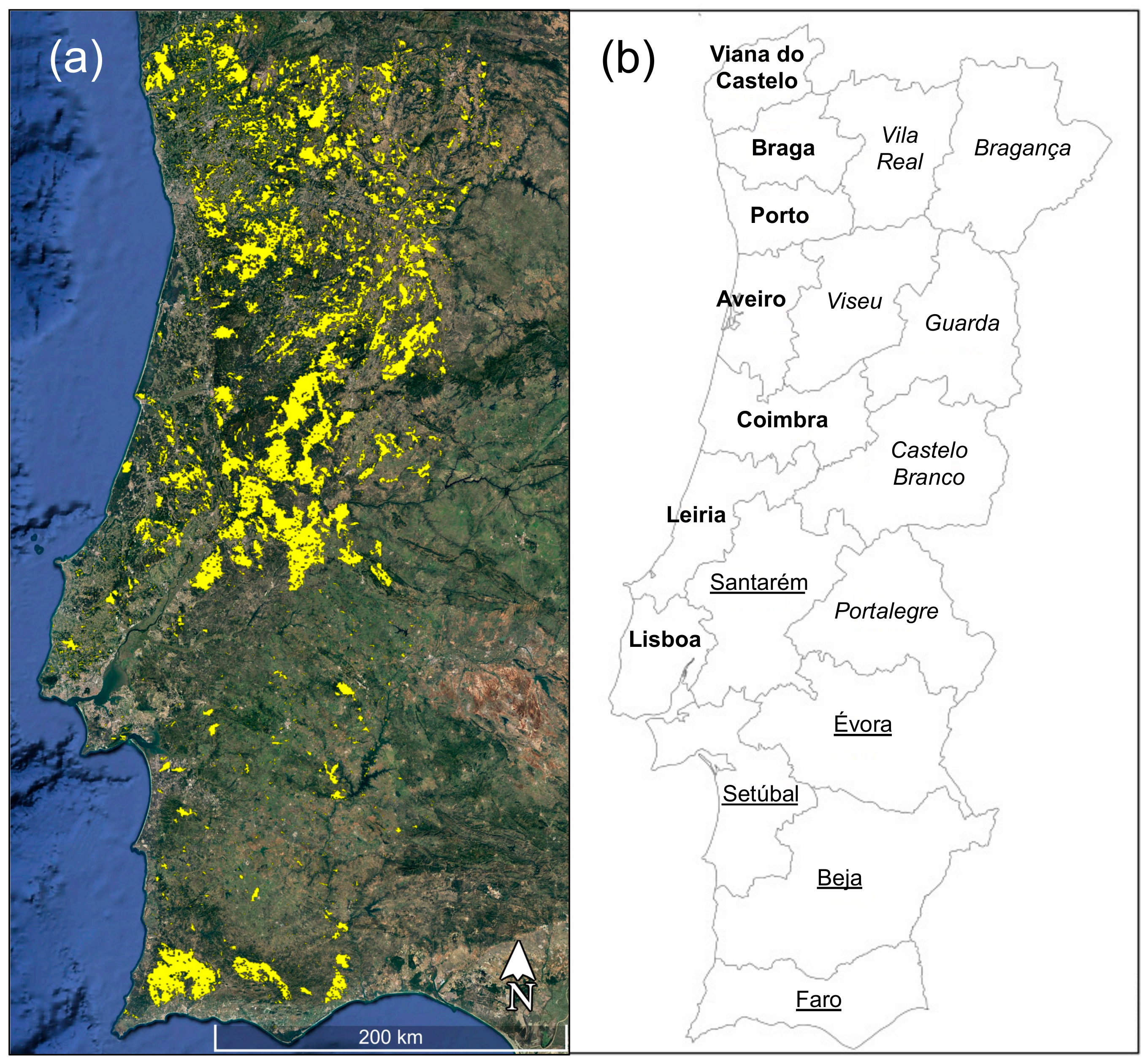
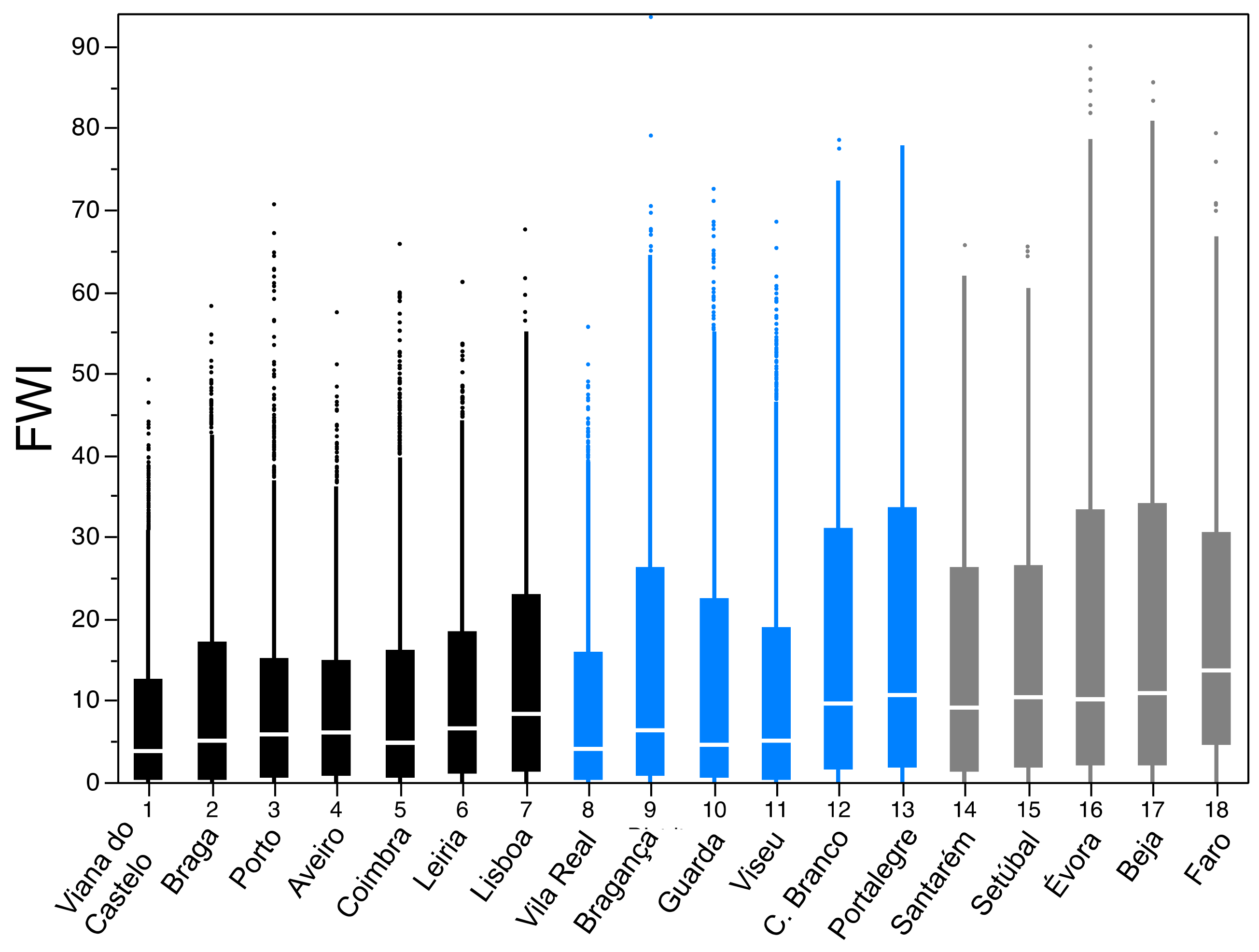
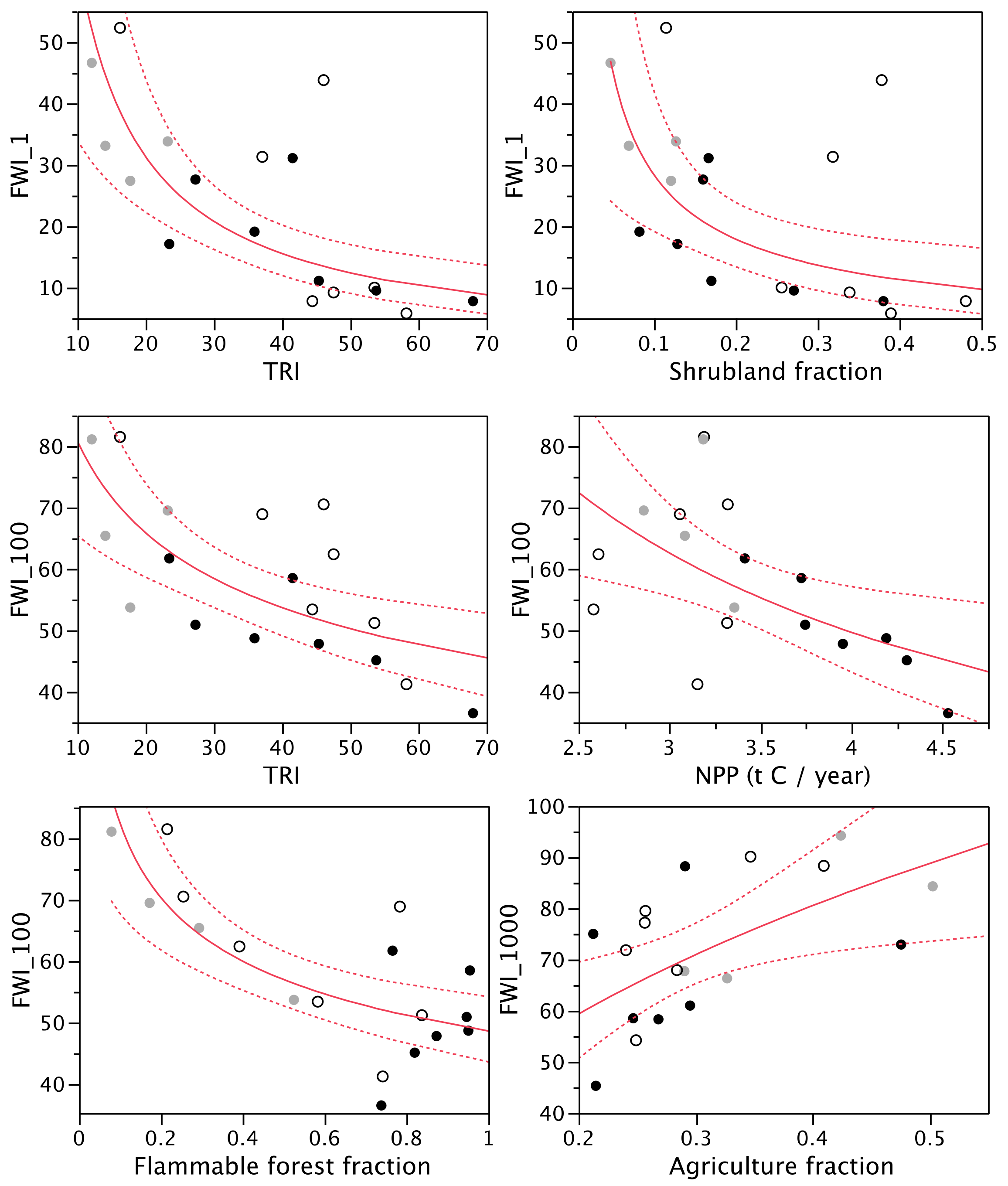
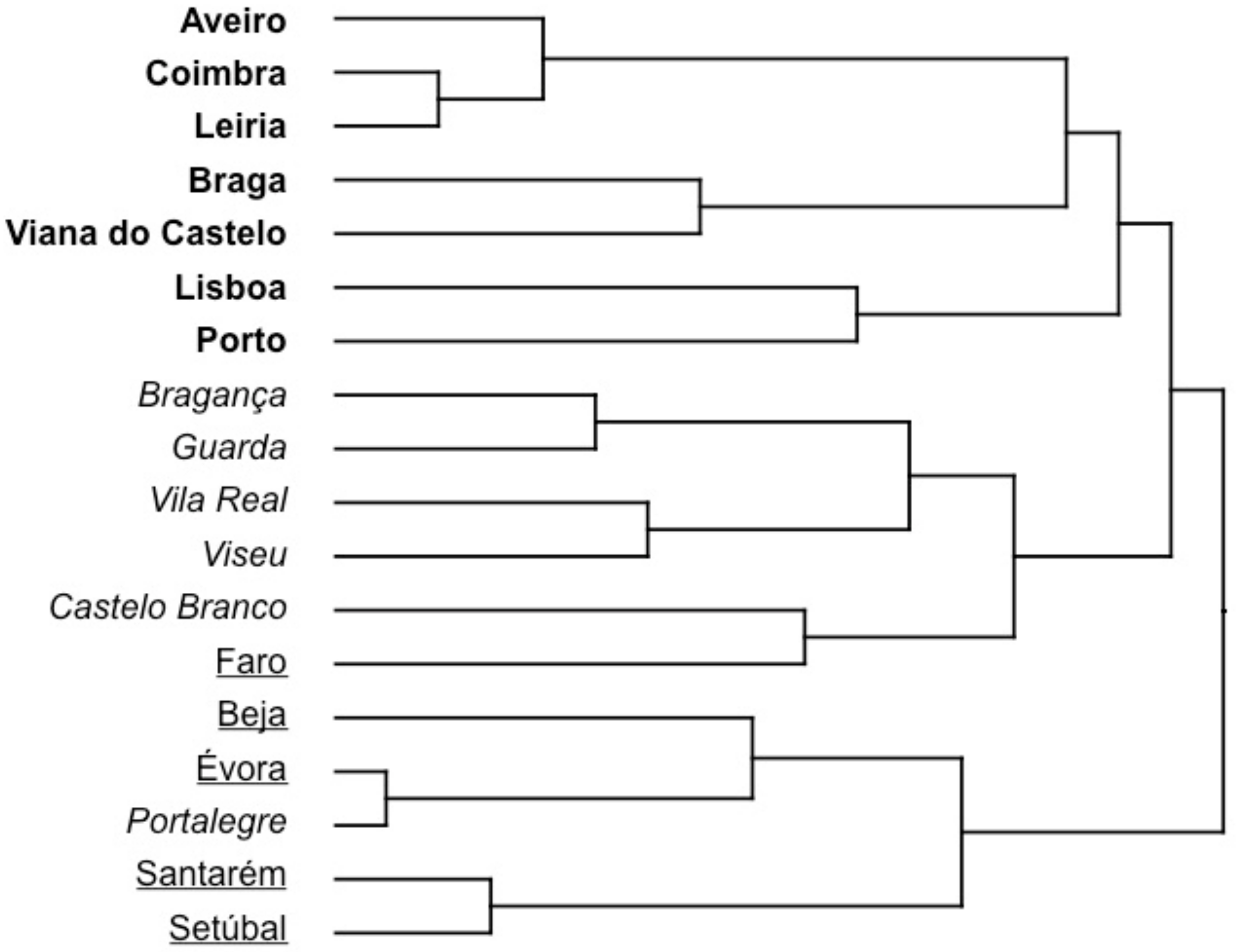
| Region | Popul. Density | Elevation | Slope | TRI | NPP | Land Cover Fractions | |||
|---|---|---|---|---|---|---|---|---|---|
| (no. km−2) | (m) | (°) | (t C year−1) | Agriculture | Shrubland | Forest | Flammable Forest * | ||
| Aveiro | 261.2 | 200 (215) | 4.8 (5.0) | 36.0 (33.0) | 4.2 (0.4) | 0.25 | 0.08 | 0.53 | 0.95 |
| Beja | 15.0 | 177 (77) | 2.5 (2.1) | 23.2 (18.8) | 2.9 (0.8) | 0.50 | 0.13 | 0.35 | 0.17 |
| Braga | 323.2 | 356 (276) | 7.7 (5.9) | 53.8 (35.5) | 4.3 (0.3) | 0.30 | 0.27 | 0.32 | 0.82 |
| Bragança | 21.9 | 610 (186) | 6.4 (4.5) | 47.6 (29.8) | 2.6 (0.5) | 0.35 | 0.34 | 0.29 | 0.39 |
| Castelo Branco | 30.2 | 408 (192) | 5.1 (4.6) | 37.1 (29.7) | 3.1 (0.5) | 0.26 | 0.32 | 0.40 | 0.78 |
| Coimbra | 109.5 | 270 (257) | 5.3 (5.4) | 41.5 (38.3) | 3.7 (0.4) | 0.21 | 0.17 | 0.52 | 0.96 |
| Évora | 22.8 | 218 (74) | 1.7 (1.2) | 12.1 (7.7) | 3.2 (0.4) | 0.42 | 0.05 | 0.50 | 0.08 |
| Faro | 87.9 | 176 (137) | 4.7 (3.7) | 46.1 (30.1) | 3.3 (1.1) | 0.26 | 0.38 | 0.26 | 0.26 |
| Guarda | 30.6 | 698 (232) | 6.0 (5.4) | 44.5 (35.7) | 2.6 (0.4) | 0.28 | 0.48 | 0.19 | 0.58 |
| Leiria | 135.0 | 199 (157) | 3.7 (3.2) | 27.3 (20.5) | 3.7 (0.5) | 0.27 | 0.16 | 0.45 | 0.95 |
| Lisboa | 801.1 | 116 (82) | 3.2 (2.8) | 23.5 (17.4) | 3.4 (0.4) | 0.48 | 0.13 | 0.18 | 0.77 |
| Portalegre | 19.8 | 272 (107) | 2.3 (2.0) | 16.2 (13.6) | 3.2 (0.4) | 0.41 | 0.11 | 0.44 | 0.22 |
| Porto | 769.7 | 253 (215) | 6.2 (5.2) | 45.4 (32.7) | 4.0 (0.3) | 0.29 | 0.17 | 0.31 | 0.87 |
| Santarém | 66.7 | 133 (94) | 2.4 (2.2) | 17.8 (14.7) | 3.4 (0.3) | 0.33 | 0.12 | 0.49 | 0.53 |
| Setúbal | 164.4 | 78 (56) | 1.8 (1.9) | 14.1 (12.9) | 3.1 (0.7) | 0.29 | 0.07 | 0.56 | 0.29 |
| Viana do Castelo | 110.3 | 386 (3249) | 10.1 (6.3) | 68.0 (36.8) | 4.5 (0.2) | 0.21 | 0.38 | 0.30 | 0.74 |
| Vila Real | 49.5 | 698 (245) | 8.3 (5.4) | 58.2 (32.4) | 3.2 (0.4) | 0.25 | 0.39 | 0.32 | 0.74 |
| Viseu | 77.3 | 562 (239) | 7.5 (5.8) | 53.5 (33.5) | 3.3 (0.7) | 0.24 | 0.26 | 0.45 | 0.84 |
| Region | Fire Size (ha) | ||||||
|---|---|---|---|---|---|---|---|
| 0.01 | 0.1 | 1 | 10 | 100 | 500 | 1000 | |
| Aveiro | 59.4 | 45.1 | 23.7 | 4.9 | 0.9 | 0.3 | 0.2 |
| Beja | 28.6 | 24.8 | 18.3 | 6.2 | 1.3 | 0.3 | 0.1 |
| Braga | 57.3 | 51.1 | 38.2 | 11.9 | 2.3 | 0.4 | 0.1 |
| Bragança | 51.3 | 47.7 | 36.6 | 11.7 | 3.3 | 0.8 | 0.4 |
| Castelo Branco | 44.5 | 36.0 | 24.1 | 5.9 | 2.3 | 1.1 | 0.7 |
| Coimbra | 45.2 | 32.1 | 14.9 | 3.3 | 1.3 | 0.6 | 0.4 |
| Évora | 23.9 | 20.8 | 13.5 | 4.1 | 1.0 | 0.3 | 0.2 |
| Faro | 34.3 | 23.3 | 13.8 | 2.6 | 0.9 | 0.4 | 0.3 |
| Guarda | 54.4 | 49.2 | 41.1 | 15.6 | 5.2 | 1.5 | 0.8 |
| Leiria | 50.2 | 36.3 | 18.0 | 3.4 | 1.2 | 0.5 | 0.2 |
| Lisboa | 62.8 | 47.6 | 35.6 | 3.6 | 0.5 | 0.1 | 0.1 |
| Portalegre | 25.9 | 20.9 | 13.1 | 3.2 | 0.7 | 0.3 | 0.2 |
| Porto | 62.0 | 51.3 | 35.5 | 9.4 | 1.9 | 0.5 | 0.1 |
| Santarém | 55.1 | 42.4 | 25.9 | 5.0 | 1.9 | 0.8 | 0.3 |
| Setúbal | 50.9 | 33.8 | 21.1 | 2.9 | 0.6 | 0.1 | 0.1 |
| Viana do Castelo | 51.0 | 44.8 | 34.4 | 11.5 | 2.6 | 0.6 | 0.2 |
| Vila Real | 58.3 | 48.4 | 40.9 | 13.1 | 3.9 | 1.1 | 0.4 |
| Viseu | 59.5 | 52.4 | 39.4 | 11.5 | 3.6 | 1.1 | 0.5 |
| Region | Fire Size (ha) | ||||||
|---|---|---|---|---|---|---|---|
| 0.01 | 0.1 | 1 | 10 | 100 | 500 | 1000 | |
| Aveiro | 0.6 (0.88; 0.11) | 6.6 (0.83; 0.24) | 19.1 (0.76; 0.29) | 38.5 (0.80; 0.07) | 48.7 (0.89; 0.01) | 53.7 (0.93; <0.01) | 58.8 (0.91; <0.01) |
| Beja | 10.0 (0.73; 0.24) | 18.5 (0.71; 0.29) | 33.8 (0.71; 0.35) | 63.7 (0.73; 0.16) | 69.5 (0.89; 0.03) | 84.3 (0.89; 0.01) | - |
| Braga | 0.0 (0.89; 0.11) | 2.3 (0.87; 0.14) | 9.5 (0.80; 0.28) | 30.8 (0.84; 0.14) | 45.1 (0.92; 0.04) | 54.6 (0.94; 0.01) | 61.0 (0.36; <0.01) |
| Bragança | 0.0 (0.76; 0.10) | 0.0 (0.75; 0.16) | 9.2 (0.72; 0.32) | 45.8 (0.79; 0.20) | 62.4 (0.86; 0.06) | 79.9 (0.83; 0.01) | 90.1 (0.86; 0.01) |
| Castelo Branco | 0.0 (0.74; 0.12) | 9.3 (0.72; 0.28) | 31.3 (0.70; 0.35) | 61.2 (0.81; 0.18) | 68.9 (0.87; 0.05) | 76.9 (0.89; 0.02) | 79.5 (0.90; 0.01) |
| Coimbra | 0.0 (0.77; 0.22) | 12.2 (0.75; 0.33) | 31.1 (0.76; 0.22) | 50.3 (0.84; 0.06) | 58.5 (0.83; 0.02) | 66.0 (0.88; 0.01) | 75.0 (0.85; 0.01) |
| Évora | 23.7 (0.75; 0.29) | 29.6 (0.74; 0.32) | 46.6 (0.73; 0.30) | 68.5 (0.80; 0.10) | 81.1 (0.88; 0.02) | 93.1 (0.93; 0.01) | 94.2 (0.96; 0.01) |
| Faro | 14.1 (0.76; 0.24) | 29.1 (0.72; 0.34) | 43.8 (0.73; 0.26) | 65.2 (0.80; 0.05) | 78.5 (0.86; 0.02) | - | - |
| Guarda | 0.0 (0.76; 0.17) | 0.0 (0.78; 0.24) | 7.8 (0.75; 0.31) | 38.9 (0.79; 0.21) | 53.4 (0.87; 0.08) | 63.6 (0.92; 0.02) | 77.9 (0.93; 0.01) |
| Leiria | 1.7 (0.82; 0.17) | 11.4 (0.77; 0.25) | 27.6 (0.76; 0.24) | 43.5 (0.89; 0.06) | 50.9 (0.93; 0.02) | 56.3 (0.94; 0.01) | 58.3 (0.97; <0.01) |
| Lisboa | 0.5 (0.88; 0.12) | 9.5 (0.86; 0.23) | 17.1 (0.83; 0.24) | 47.4 (0.88; 0.04) | 61.7 (0.94; 0.01) | 72.9 (0.93; <0.01) | - |
| Portalegre | 16.8 (0.68; 0.33) | 30.5 (0.68; 0.36) | 52.3 (0.67; 0.32) | 75.6 (0.77; 0.08) | 81.5 (0.85; 0.02) | - | 88.3 (0.92; 0.01) |
| Porto | 0.2 (0.91; 0.09) | 4.4 (0.90; 0.15) | 11.1 (0.87; 0.21) | 31.4 (0.87; 0.12) | 47.8 (0.94; 0.03) | 62.7 (0.96; 0.01) | 88.2 (0.97; <0.01) |
| Santarém | 0.4 (0.84; 0.13) | 11.3 (0.78; 0.26) | 27.4 (0.77; 0.29) | 47.8 (0.88; 0.08) | 53.7 (0.32; 0.03) | 58.9 (0.93; 0.01) | 66.3 (0.93; 0.01) |
| Setúbal | 8.2 (0.86; 0.19) | 20.9 (0.80; 0.27) | 33.1 (0.77; 0.27) | 59.3 (0.82; 0.04) | 65.4 (0.91; 0.01) | 65.5 (0.98; <0.01) | 67.7 (>0.99; <0.01) |
| Viana do Castelo | 0.0 (0.82; 0.12) | 1.7 (0.79; 0.20) | 7.8 (0.77; 0.32) | 26.0 (0.78; 0.17) | 36.5 (0.88; 0.04) | 43.0 (0.94; 0.01) | 45.3 (0.99; 0.01) |
| Vila Real | 0.0 (0.85; 0.07) | 0.6 (0.79; 0.19) | 5.8 (0.76; 0.29) | 30.5 (0.80; 0.18) | 41.2 (0.88; 0.06) | 50.6 (0.91; 0.02) | 54.2 (0.95; 0.01) |
| Viseu | 0.0 (0.83; 0.10) | 0.6 (0.81; 0.19) | 10.0 (0.77; 0.30) | 38.5 (0.82; 0.16) | 51.2 (0.90; 0.05) | 62.6 (0.92; 0.02) | 71.8 (0.91; 0.01) |
| Fire-Size Thresholds | FWI | |||||||
|---|---|---|---|---|---|---|---|---|
| 0.1 | 1 | 10 | 100 | 500 | 1000 | Median | 90th Perc. | |
| 0.01 | 0.902 | 0.819 | 0.789 | 0.794 | 0.673 ** | 0.541 * | 0.719 | 0.666 ** |
| 0.1 | 0.963 | 0.889 | 0.827 | 0.655 ** | 0.483 * | 0.853 | 0.620 ** | |
| 1 | 0.928 | 0.851 | 0.677 ** | 0.501 * | 0.828 | 0.668 ** | ||
| 10 | 0.969 | 0.834 | 0.659 ** | 0.875 | 0.859 | |||
| 100 | 0.922 | 0.786 | 0.819 | 0.888 | ||||
| 500 | 0.879 | 0.697 ** | 0.839 | |||||
| 1000 | 0.525 * | 0.717 | ||||||
| Variable | 1 ha | 100 ha | 1000 ha |
|---|---|---|---|
| Popul. density | *0.22 (−) | ||
| Elevation | 0.44 (−) | ||
| TRI | 0.56 (−) | 0.48 (−) | |
| NPP | 0.33 (−) | 0.29 (−) | |
| Land cover fractions | |||
| Agriculture | 0.33 (+) | ||
| Shrubland | 0.39 (−) | ||
| Forest | 0.24 (−) | ||
| Flammable forest | 0.32 (−) | 0.54 (−) | 0.32 (−) |
© 2019 by the author. Licensee MDPI, Basel, Switzerland. This article is an open access article distributed under the terms and conditions of the Creative Commons Attribution (CC BY) license (http://creativecommons.org/licenses/by/4.0/).
Share and Cite
Fernandes, P.M. Variation in the Canadian Fire Weather Index Thresholds for Increasingly Larger Fires in Portugal. Forests 2019, 10, 838. https://doi.org/10.3390/f10100838
Fernandes PM. Variation in the Canadian Fire Weather Index Thresholds for Increasingly Larger Fires in Portugal. Forests. 2019; 10(10):838. https://doi.org/10.3390/f10100838
Chicago/Turabian StyleFernandes, Paulo M. 2019. "Variation in the Canadian Fire Weather Index Thresholds for Increasingly Larger Fires in Portugal" Forests 10, no. 10: 838. https://doi.org/10.3390/f10100838
APA StyleFernandes, P. M. (2019). Variation in the Canadian Fire Weather Index Thresholds for Increasingly Larger Fires in Portugal. Forests, 10(10), 838. https://doi.org/10.3390/f10100838




